Key takeaways:
- Agile retrospectives foster a culture of trust and transparency, allowing teams to reflect on successes and failures together.
- Creating a safe environment for open discussion and using structured techniques like “Start, Stop, Continue” enhances candid feedback and actionable insights.
- Regular retrospectives promote continuous improvement, encouraging teams to celebrate achievements and address challenges in a supportive atmosphere.
- Assigning ownership of action items during retrospectives ensures accountability and helps translate discussions into tangible outcomes.
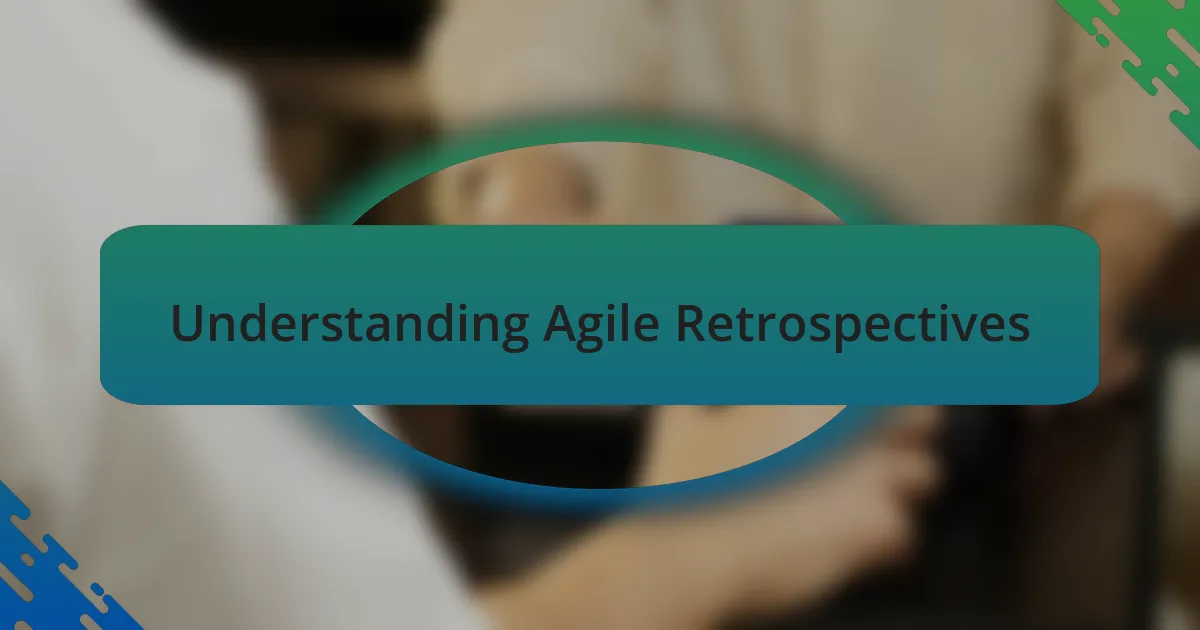
Understanding Agile Retrospectives
Agile retrospectives are an essential part of the Agile methodology, serving as a dedicated time for teams to reflect on their recent work. I remember the first time I participated in one; it felt a bit awkward at first, but the openness in sharing our thoughts was refreshing. It prompted me to consider what truly makes a team effective—how often do we take a step back and evaluate our processes?
During these meetings, teams discuss what went well, what could be improved, and what actions they can take moving forward. This isn’t just a formality; it’s a valuable moment to foster trust and transparency. I’ve seen teams transform their dynamics through these discussions—there’s something powerful about acknowledging both triumphs and failures together.
It can be tempting to focus solely on problem-solving, but I’ve learned that fostering a culture of appreciation is equally vital. How often do we express gratitude for the little wins? By celebrating these moments, teams feel more connected, ultimately leading to higher morale and better performance.
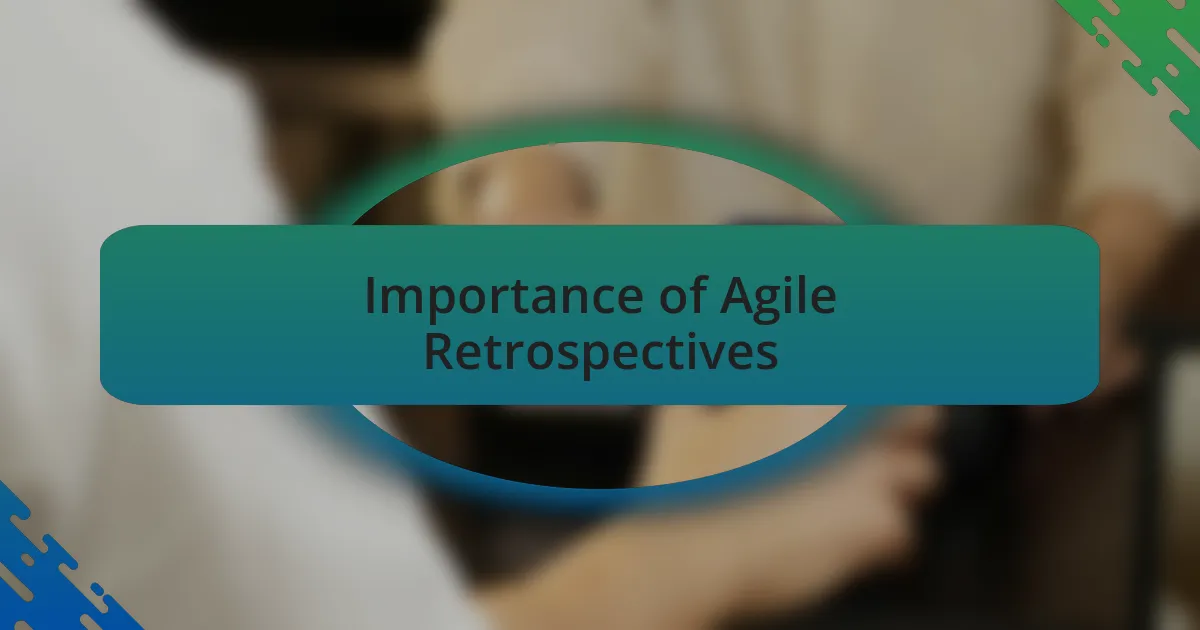
Importance of Agile Retrospectives
One of the key reasons Agile retrospectives are so important is that they provide a structured opportunity for continuous improvement. I recall a particular retrospective where we identified a bottleneck in our process that had been hindering our progress for weeks. In that moment, I realized how crucial it is to have a safe space where team members can voice concerns without fear of judgment; it’s about uncovering those hidden obstacles together.
These meetings aren’t just about addressing failures—they’re also about celebrating successes. One time, we took a moment to acknowledge a team member who had gone above and beyond to help a colleague meet a tight deadline. This celebration not only boosted that individual’s confidence but also strengthened our bond as a team. Don’t you think that recognizing contributions can ignite a sense of ownership and commitment among team members?
Furthermore, retrospectives cultivate a culture of openness and accountability. I’ve experienced teams where individuals felt hesitant to share feedback, which ultimately stifled growth. It begs the question, how can we expect improvement if we aren’t willing to confront uncomfortable truths? Emphasizing candid dialogue in retrospectives fosters an environment where everyone feels heard, leading to actionable insights that drive the team forward.
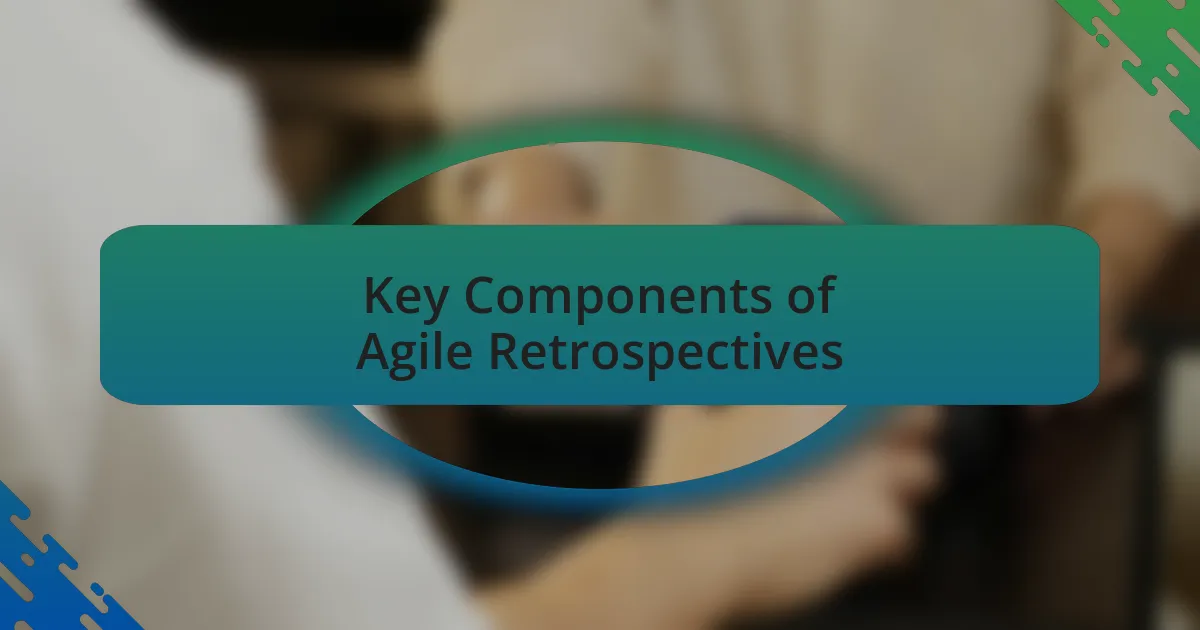
Key Components of Agile Retrospectives
Key Components of Agile Retrospectives
One of the core components of Agile retrospectives is the creation of a safe environment for open discussion. I remember a time when our team was grappling with a project that wasn’t meeting its milestones. As we gathered for our retrospective, the atmosphere felt tense. But by encouraging everyone to share honestly, even about the difficulties we faced, we discovered common concerns that had been holding us back. Isn’t it ironic how simply talking can reveal solutions we hadn’t seen before?
Another pivotal aspect is the focus on actionable outcomes. During one retrospective, a colleague suggested a new way to manage our sprint tasks that seemed a bit out of the box. We implemented it immediately, and the results were phenomenal. Suddenly, we were meeting our deadlines without compromising quality. Moments like that illustrate the practical value of retrospectives—they turn discussions into tangible changes. How often do we overlook the potential for innovation just because we stick to our usual methods?
Lastly, using data to drive discussions can be incredibly powerful. I once led a retrospective where we analyzed our velocity charts and realized we were consistently underperforming. By examining this data together, we identified specific areas for improvement and set measurable goals for the next sprint. This shift not only created accountability but also highlighted the importance of defining success in clear, quantifiable terms. Isn’t it empowering to see how tangible evidence can guide our strategies and lead to a stronger, more cohesive team?
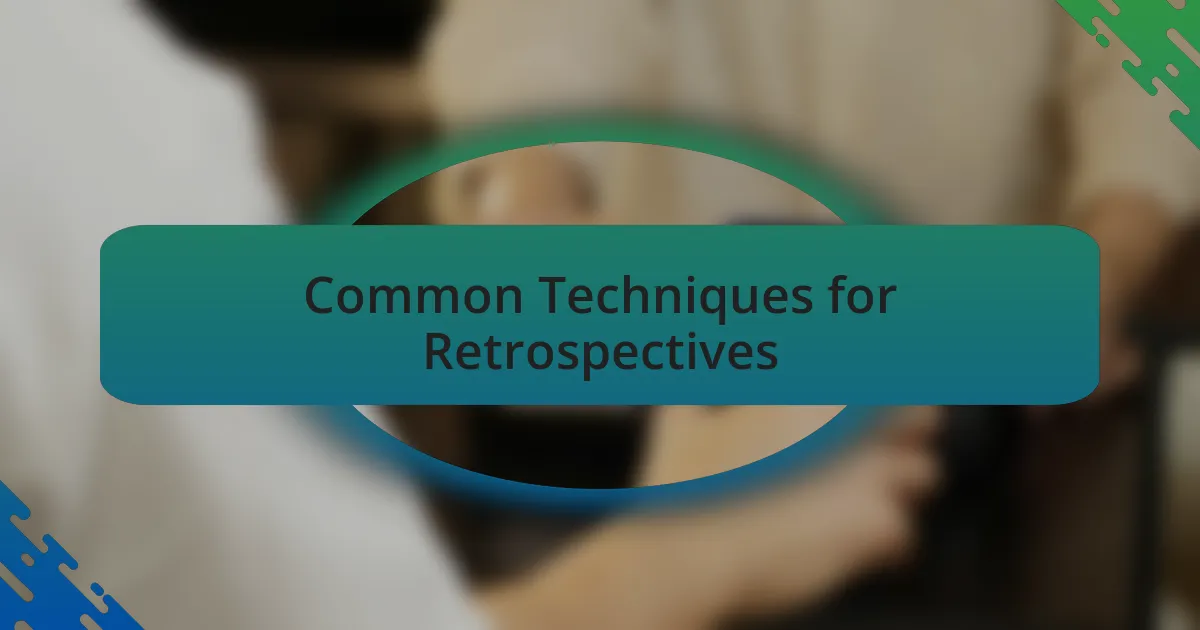
Common Techniques for Retrospectives
One popular technique I’ve used in retrospectives is the “Start, Stop, Continue” method. In one instance, the team gathered to discuss our processes after a particularly rough sprint. It felt liberating to categorize our thoughts—what should we start doing to improve, what needs to stop, and what’s working that we should continue? This structured approach opened the floor for candid conversations, transforming frustration into actionable insights. Have you ever noticed how categorizing thoughts can streamline a chaotic discussion?
Another effective technique involves using “Silent Brainstorming.” I recall a time when the energy in the room was low, and team members hesitated to share their inputs. By giving everyone a few minutes to jot down their thoughts silently before sharing, we unlocked a treasure trove of ideas that might have gone unsaid in a more vocal environment. It’s fascinating how a little silence can foster creativity, don’t you think?
Lastly, I’ve found “Dot Voting” to be a fantastic way of prioritizing issues. During one retrospective, the team listed everything we felt required attention, and then we each placed dots next to our top concerns. It was eye-opening to see which issues resonated most with the group, guiding our discussions toward what mattered most. This technique not only helped us focus but also built a sense of camaraderie as we aligned our team goals. How often do we end up talking in circles without a clear direction?
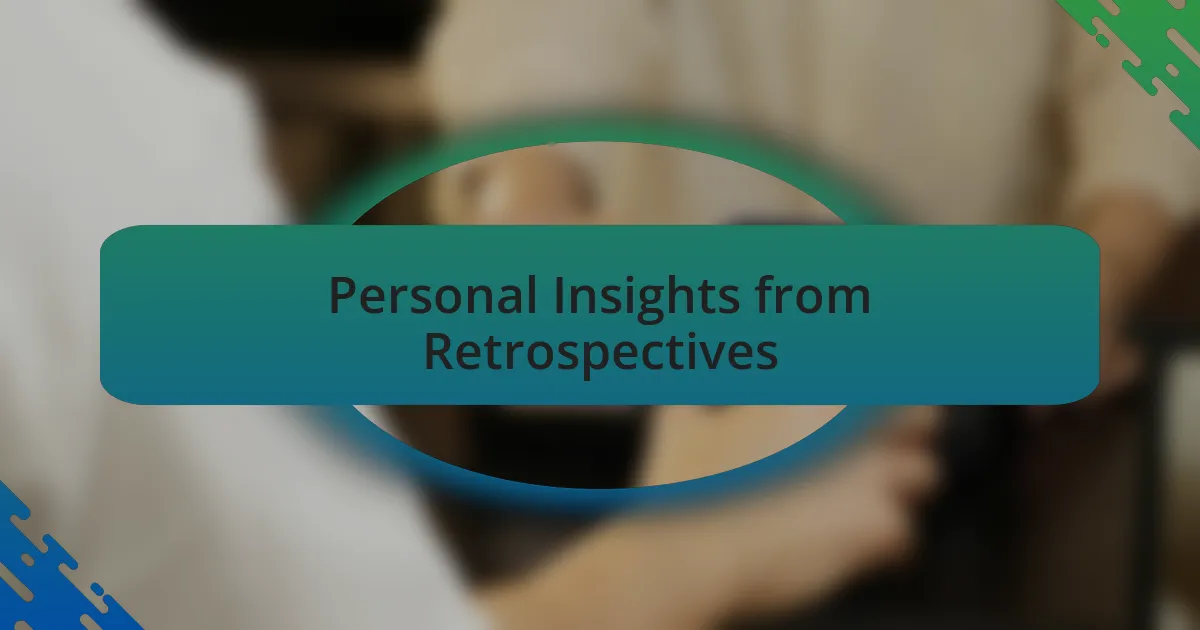
Personal Insights from Retrospectives
Reflecting on my experiences during retrospectives, I’ve come to appreciate the power of vulnerability within the team. I remember one specific session when a team member shared a significant mistake they made, and instead of judgment, we all rallied to support and learn from that lesson. It struck me how these moments of honesty not only deepen trust but also pave the way for a more cohesive team dynamic. Have you ever felt that shared vulnerability can transform a team into a support system?
Another insight that stands out is how retrospectives serve as a mirror for personal growth. There was a time I felt frustrated because my contributions weren’t being recognized. During a retrospective, I voiced this concern, and my teammates provided feedback that shifted my perspective. I realized that sometimes, the value of my contributions lies in supporting others, and this acknowledgment helped me embrace my role within the team. It’s intriguing how self-reflection during these meetings can unveil new dimensions of ourselves that we might overlook.
Lastly, I’ve noticed that consistency in conducting retrospectives can foster an environment of continuous improvement. One of my teams set a rule to reserve time for retrospectives at the end of each sprint, and it quickly became something we all looked forward to. This regularity not only allowed us to celebrate small wins but also cultivated an ongoing dialogue about what truly matters, leading to sustained team engagement. Isn’t it fascinating how such routine practices can create a culture of accountability and growth?

Applying Learnings in Future Projects
Applying what I’ve learned in retrospectives to future projects has been transformative for me. For instance, after recognizing the importance of clear communication in one session, I made it a point to establish regular touchpoints with my team in subsequent projects. This proactive approach not only minimized misunderstandings but also ensured everyone felt heard—have you found that clearer communication can enhance team performance?
I remember a project where we struggled to meet deadlines, highlighted in one of our retrospectives. The team collectively identified that we hadn’t factored in buffer time adequately. Taking this insight into my next project, I proposed scheduled buffers in our planning phases, and I was amazed at how it helped alleviate stress and kept everyone on track. Isn’t it interesting how a single observation can drastically alter project management strategies?
Another key takeaway for me was the emphasis on celebrating success. After one retrospective, I realized that we often focused on solving problems but overlooked acknowledging achievements. In future projects, I initiated milestone celebrations, and the boost in morale was palpable. How do celebrations at project milestones impact your team’s motivation and morale?
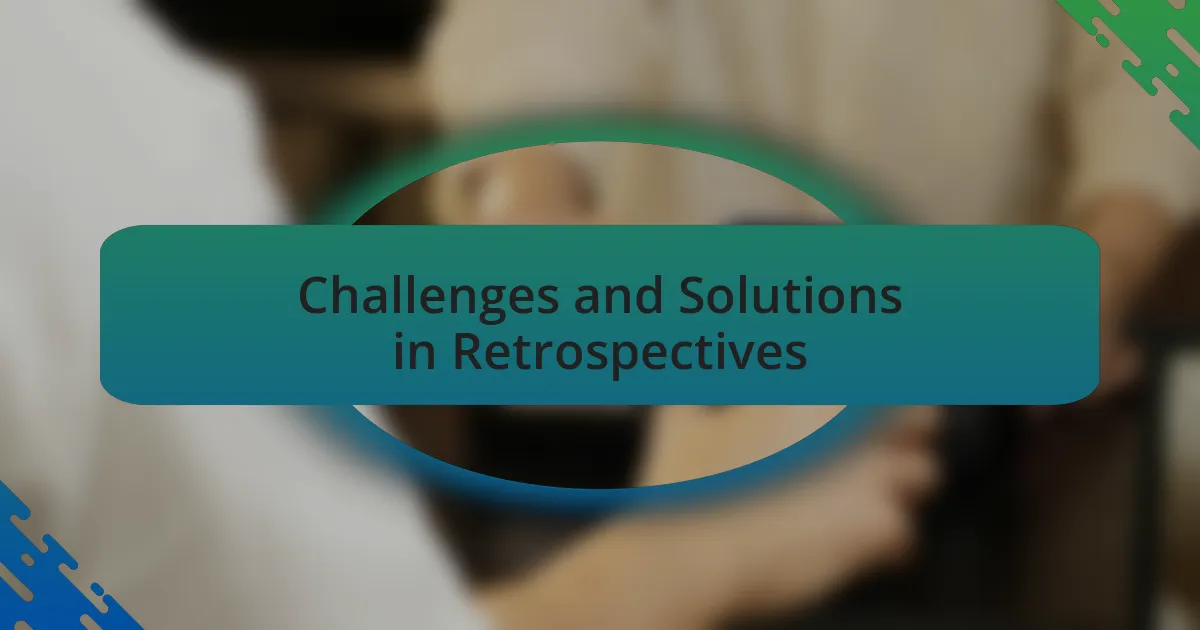
Challenges and Solutions in Retrospectives
Retrospectives can sometimes feel like a ritual rather than a productive exercise. In one session, I witnessed a team member shutting down whenever feedback was shared, which created an uncomfortable atmosphere. To address this, I introduced a “silent brainstorming” method where everyone could write their thoughts anonymously first. This not only freed people to speak up but also led to richer discussions—ever found that anonymity can spark openness in tough conversations?
Another challenge I’ve encountered is when discussions stray off-topic, leading to frustratingly long meetings. I remember a retrospective where we spent too much time on unrelated grievances. To combat this, I suggested implementing a timekeeper who could gently bring us back on track when conversations wandered. It was a small change, but the focus and efficiency of the meeting improved significantly—have you tried setting strict agendas to keep discussions from derailing?
Finally, there’s the issue of actionable items often left unaddressed after a retrospective. I once ended a session with a list of great ideas, only to find them gathering dust. To counteract this, I began assigning specific owners to each action item, setting deadlines during our retrospectives themselves. This accountability transformed our follow-ups and ensured we actually learned from our discussions—what methods do you use to turn ideas into action?